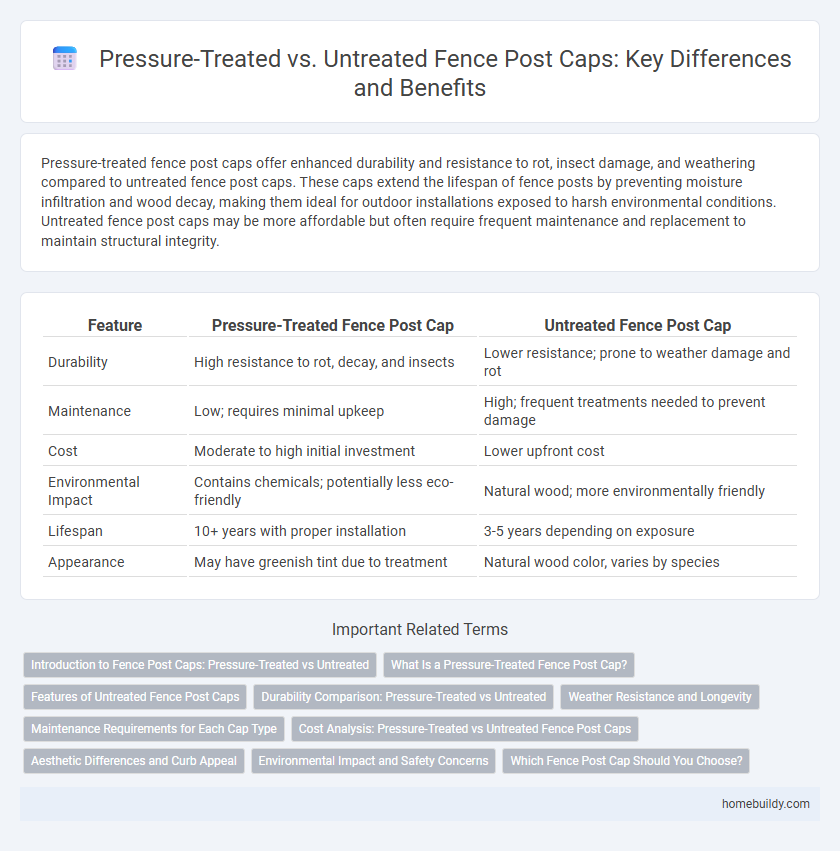Pressure-treated fence post caps offer enhanced durability and resistance to rot, insect damage, and weathering compared to untreated fence post caps. These caps extend the lifespan of fence posts by preventing moisture infiltration and wood decay, making them ideal for outdoor installations exposed to harsh environmental conditions. Untreated fence post caps may be more affordable but often require frequent maintenance and replacement to maintain structural integrity.
Table of Comparison
| Feature | Pressure-Treated Fence Post Cap | Untreated Fence Post Cap |
|---|---|---|
| Durability | High resistance to rot, decay, and insects | Lower resistance; prone to weather damage and rot |
| Maintenance | Low; requires minimal upkeep | High; frequent treatments needed to prevent damage |
| Cost | Moderate to high initial investment | Lower upfront cost |
| Environmental Impact | Contains chemicals; potentially less eco-friendly | Natural wood; more environmentally friendly |
| Lifespan | 10+ years with proper installation | 3-5 years depending on exposure |
| Appearance | May have greenish tint due to treatment | Natural wood color, varies by species |
Introduction to Fence Post Caps: Pressure-Treated vs Untreated
Pressure-treated fence post caps provide enhanced durability and resistance to rot, insects, and weathering due to chemical preservatives infused during the treatment process. Untreated fence post caps, while typically more affordable and natural in appearance, lack this protective barrier and may require more frequent maintenance or replacement over time. Choosing pressure-treated caps extends the lifespan of fence posts, especially in harsh outdoor conditions, whereas untreated caps suit projects prioritizing eco-friendliness and ease of painting or staining.
What Is a Pressure-Treated Fence Post Cap?
A pressure-treated fence post cap is a protective cover made from wood that has been chemically treated under high pressure to resist rot, decay, and insect damage. Unlike untreated fence post caps, pressure-treated versions offer enhanced durability and longevity, especially in outdoor environments exposed to moisture and harsh weather conditions. This treatment process significantly extends the lifespan of fence posts by preventing water infiltration and fungal growth.
Features of Untreated Fence Post Caps
Untreated fence post caps are typically made from natural wood without chemical additives, preserving the wood's original appearance and texture. These caps offer a more environmentally friendly option, allowing the wood to age naturally and requiring regular maintenance to prevent decay and weathering. Their organic composition provides aesthetic appeal in rustic or traditional fence designs but may have a shorter lifespan compared to pressure-treated alternatives.
Durability Comparison: Pressure-Treated vs Untreated
Pressure-treated fence post caps offer superior durability due to their resistance to rot, decay, and insect damage, significantly extending the lifespan of outdoor fencing structures. Untreated fence post caps lack this protective treatment, making them more susceptible to weathering and requiring more frequent replacement. Choosing pressure-treated caps ensures long-term structural integrity and reduces maintenance costs over time.
Weather Resistance and Longevity
Pressure-treated fence post caps offer superior weather resistance by repelling moisture, preventing rot, and deterring insect damage, significantly extending the lifespan of fence posts in harsh outdoor conditions. Untreated fence post caps lack protective chemical treatments, making them more susceptible to water absorption, warping, and decay over time. Choosing pressure-treated caps enhances durability and minimizes maintenance, ensuring long-term structural integrity for fencing projects.
Maintenance Requirements for Each Cap Type
Pressure-treated fence post caps require less frequent maintenance due to their enhanced resistance to rot, insects, and weather damage, extending the lifespan of the fence posts. Untreated fence post caps often need regular sealing or painting to protect against moisture and UV damage, making upkeep more intensive and essential to prevent wood decay. Selecting pressure-treated caps reduces long-term maintenance efforts and costs associated with fence post deterioration.
Cost Analysis: Pressure-Treated vs Untreated Fence Post Caps
Pressure-treated fence post caps typically cost 20-30% more than untreated caps due to the added chemical preservatives that protect against rot and insect damage, extending the lifespan by up to 50%. Untreated fence post caps have lower upfront costs but may require replacement every 5-7 years, increasing long-term expenses. Investing in pressure-treated caps reduces maintenance costs and improves fence durability, providing better value over time despite higher initial pricing.
Aesthetic Differences and Curb Appeal
Pressure-treated fence post caps exhibit a uniform, greenish hue that can appear more artificial compared to the natural wood tones of untreated caps, which age gracefully to a silvery-gray patina, enhancing rustic charm. The smooth finish and consistent color of untreated caps tend to blend seamlessly with various landscaping styles, boosting curb appeal by highlighting the natural grain and texture. In contrast, pressure-treated caps may show chemical staining or surface corrosion over time, potentially detracting from a polished fence appearance.
Environmental Impact and Safety Concerns
Pressure-treated fence post caps provide enhanced durability and resistance to rot and insect damage, reducing the need for frequent replacements and minimizing environmental waste. However, the chemicals used in pressure treatment can potentially leach into surrounding soil, posing safety concerns for plants, pets, and children. Untreated fence post caps avoid chemical exposure risks but typically have a shorter lifespan, potentially increasing resource consumption and waste over time.
Which Fence Post Cap Should You Choose?
Pressure-treated fence post caps offer enhanced durability and resistance to rot, insects, and weather damage, making them ideal for outdoor use in harsh climates. Untreated fence post caps can be more affordable and visually appealing but require regular maintenance and sealing to extend their lifespan. Choose pressure-treated caps for long-term protection and low maintenance, while untreated caps suit decorative purposes with proper care.
pressure-treated fence post cap vs untreated fence post cap Infographic

 homebuildy.com
homebuildy.com